
Hyphaene thebaica, with common names doum palm and gingerbread tree, is a type of palm tree with edible oval fruit. It is a native to the Arabian Peninsula and also to the northern half and western part of Africa where it is widely distributed and tends to grow in places where groundwater is present.

Hyphaene is a genus of palms native to Africa, Madagascar, the Middle East, and the Indian subcontinent.
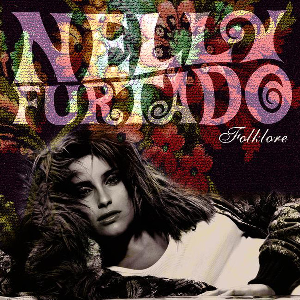
Folklore is the second studio album by Canadian singer-songwriter Nelly Furtado. It was released on 23 November 2003 through DreamWorks Records. While the album did not match the success of her previous album in such markets as the United States and Australia, it did however become a success in several European countries. Folklore spawned five singles: "Powerless ", "Try", "Força", "Explode" and "The Grass Is Green". The album has sold 2 million copies worldwide.
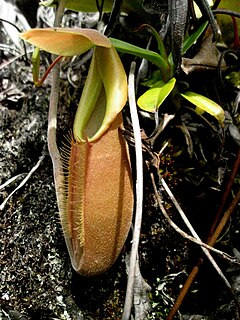
Nepenthes bongso is a tropical pitcher plant endemic to Sumatra, where it has an altitudinal distribution of 1000–2700 m above sea level. The specific epithet bongso refers to the Indonesian legend of Putri Bungsu, the spirit guardian of Mount Marapi.

Nepenthes ramispina is a highland Nepenthes pitcher plant species, native to Peninsular Malaysia. It was once regarded as being similar to N. gracillima, but studies of the two species in nature have shown that they are readily distinguishable in isolation, N. gracillima being far more readily confused with N. macfarlanei in its rosette stage.

Marcescence is the retention of dead plant organs that normally are shed. Trees transfer water and sap from the roots to the leaves through their vascular cells, but in some trees as autumn begins, the veins carrying the sap slowly close until a layer of cells called the abscission layer completely closes off the vein allowing the tree to rid itself of the leaf. Leaf marcescence is most often seen on juvenile plants and may disappear as the tree matures. It also may not affect the entire tree; sometimes leaves persist only on scattered branches. Marcescence is most obvious in deciduous trees that retain leaves through the winter. Trees that exhibit marcescene are known as "everciduous". Several trees normally have marcescent leaves such as oak (Quercus), beech (Fagus) and hornbeam (Carpinus), or marcescent stipules as in some but not all species of willows (Salix). All oak trees may display foliage marcescence, even species that are known to fully drop leaves when the tree is mature. Marcescent leaves of pin oak complete development of their abscission layer in the spring. The base of the petiole remains alive over the winter. Many other trees may have marcescent leaves in seasons where an early freeze kills the leaves before the abscission layer develops or completes development. Diseases or pests can also kill leaves before they can develop an abscission layer.
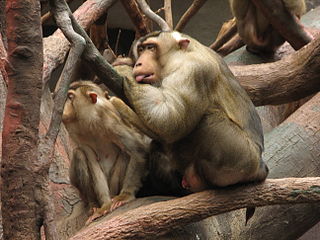
The southern pig-tailed macaque, also known as the Sundaland pig-tailed macaque and Sunda pig-tailed macaque, is a medium-sized macaque that lives in southern Thailand, Malaysia, and Indonesia. It is known locally as the beruk.

The Raffles' banded langur, also known as the banded leaf monkey or banded surili, is a species of primate in the family Cercopithecidae. It is endemic to Singapore and southern Peninsular Malaysia. The species underwent taxonomic revisions in 2019 and 2020, in which two former subspecies were elevated to separate species. As a result, the Raffles' banded langur meets the criteria for being listed as vulnerable by the IUCN. It is mainly threatened by habitat loss.

Aquilaria malaccensis is a species of plant in the Thymelaeaceae family. It is found in Bangladesh, Bhutan, India, Indonesia, Laos, Malaysia, Myanmar, the Philippines, Singapore, and Thailand. It is threatened by habitat loss.
Horsfieldia sparsa is a species of plant in the family Myristicaceae. It is a tree that grows naturally in Sumatra, Peninsular Malaysia, Singapore and Thailand.
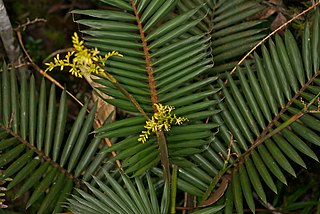
Calamus gibbsianus is a species of rattan palm in the genus Calamus endemic to the Malaysian States of Sarawak and Sabah on the island of Borneo.

Isaac Henry Burkill was an English botanist who worked in India and in the Straits Settlements. He worked primarily in economic botany but published extensively on plant biology, ethno-botany, insect-plant interactions and described several species. He published a two volume compilation on the plants of economic importance in the Malay Peninsula, collating local names and knowledge. He also wrote a detailed history of botany in India. The plant genera Burkillia and Burkillianthus were named in his honour.
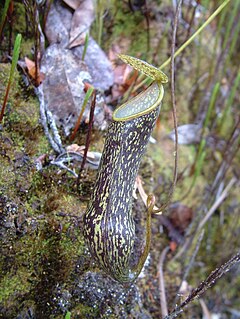
Nepenthes nigra is a tropical pitcher plant known from a number of mountains across Central Sulawesi, where it grows at elevations of 1500–2700 m above sea level. The specific epithet nigra refers to the dark colouration of the pitchers and stem. The species is closely related to N. hamata and N. tentaculata.

Hyphaene petersiana, the real fan palm or makalani palm, is a palm tree native to the subtropical, low-lying regions of south central Africa.
H. dichotoma may refer to:
Nepenthes abalata is a tropical pitcher plant known from three western islands of the Philippines: Culion, Cuyo, and Malalison. It has been recorded from coastal grassland and scrub at elevations of 0–20 m above sea level.
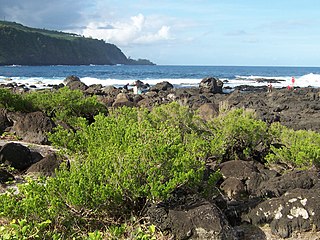
Pemphis acidula, commonly known as bantigue or mentigi, is a species of flowering plant in the family Lythraceae. It is a mangrove found throughout most of the tropical Indo-Pacific growing on rocky shores. The genus Pemphis, to which it belongs, was until recently thought to have only this single species, first described in 1775 and long considered the type species, but is now believed to have at least one other.
Persicaria dichotoma is a species of flowering plant native to Australia and Asia.

Borasseae is a tribe in the palm subfamily Coryphoideae. The tribe ranges from southern Africa and Madagascar north through the Arabian Peninsula to India, Indochina, Indonesia and New Guinea. Several genera are restricted to islands in the Indian Ocean. The two largest genera, Hyphaene and Borassus, are also the most widespread.
















